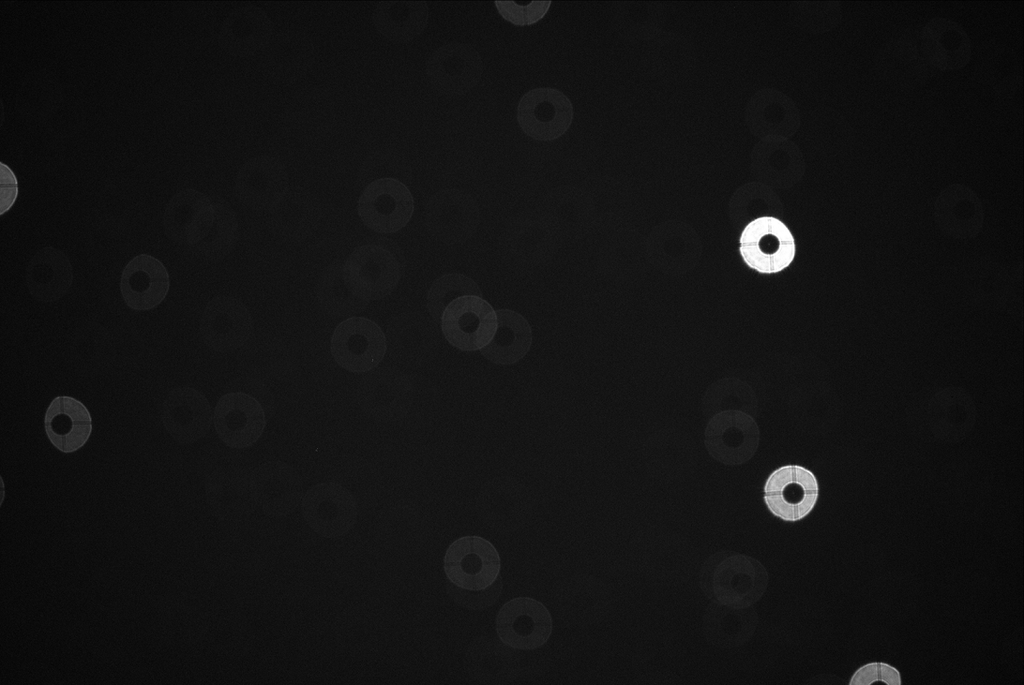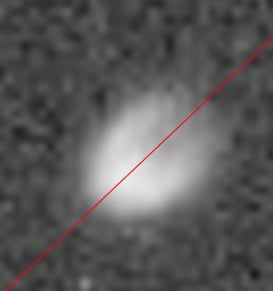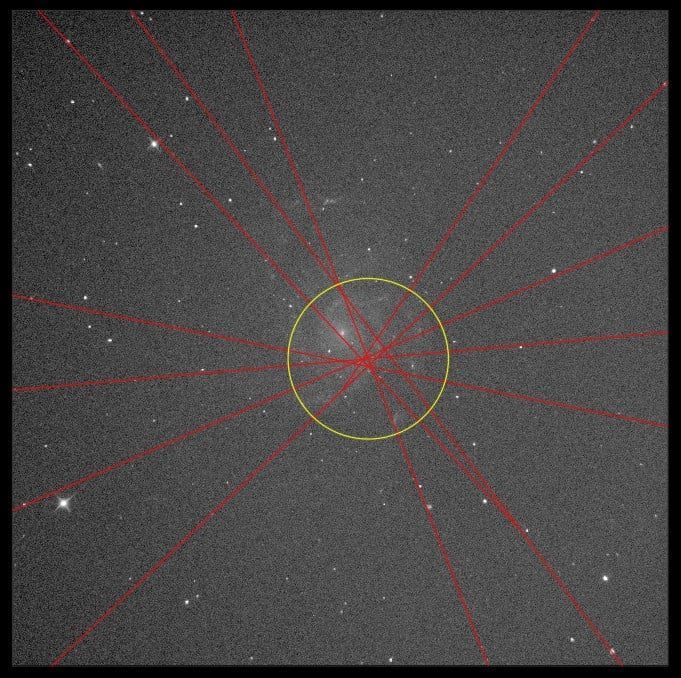Hello. I had this issue for years and still wasn't solved, but now decided back astrophotography. Used different collimation methods. - Catseye - TSMKOLLI - Laser, Cheshire etc. Tested on: - TS-Optics Newtonian Coma Corrector 1.0x TSGPU - 4-element - 2" - 21 + 16.5mm rings + 17.5mm camera native backfocus = 55mm SW Quattro 250P (254/1000) ZWO ASI 2600MM Duo Tried to change focuser angle using collimation screws. Tried to change camera(ST8300M, EOS 70D), tried to remove coma corrector. Almost the same results, deformatted stars and cut circles when defocused.  Is any way to detect if primary mirror is deformated or got damager during time ? Visually mirror is fine, no scratches, almost no dust. We have no any services or professionals here to test it, so only way to check all the possible things by myself.
|
You cannot like this item. Reason: "ANONYMOUS".
You cannot remove your like from this item.
Editing a post is only allowed within 24 hours after creating it.
You cannot Like this post because the topic is closed.
Copy the URL below to share a direct link to this post.
This post cannot be edited using the classic forums editor.
To edit this post, please enable the "New forums experience" in your settings.
You can only gauge the collimation with a centered star, the ones to the edges will be way off due to the angle of incidence of the light coming down the tube past the central obstruction. Your collimation, based on the centre most out of focus star, looks quite reasonable. It's not perfect but it's not bad.
|
You cannot like this item. Reason: "ANONYMOUS".
You cannot remove your like from this item.
Editing a post is only allowed within 24 hours after creating it.
You cannot Like this post because the topic is closed.
Copy the URL below to share a direct link to this post.
This post cannot be edited using the classic forums editor.
To edit this post, please enable the "New forums experience" in your settings.
You mean cut circles is ok? I never had that before. And actual focused image is awful, stars is not clean, weird shaped, focused with APT Bakhtinov AID. Images is blurry.
It's feels like i found best focus position, but it's still defocused. I had way better images on GSO 150/750 and no issues with collimation at all. Here i tried seems most of the methods and collimation tools, and zero success as result.
|
You cannot like this item. Reason: "ANONYMOUS".
You cannot remove your like from this item.
Editing a post is only allowed within 24 hours after creating it.
You cannot Like this post because the topic is closed.
Copy the URL below to share a direct link to this post.
This post cannot be edited using the classic forums editor.
To edit this post, please enable the "New forums experience" in your settings.
You can't test for collimation or collimate with a coma corrector in place and, secondly, you need to be close to focus and, with a image scale large enough, with in-focus images (or high power EP which frankly is the best option). Try MetaGuide collimation.
|
You cannot like this item. Reason: "ANONYMOUS".
You cannot remove your like from this item.
Editing a post is only allowed within 24 hours after creating it.
You cannot Like this post because the topic is closed.
Copy the URL below to share a direct link to this post.
This post cannot be edited using the classic forums editor.
To edit this post, please enable the "New forums experience" in your settings.
And just to be perfectly clear, mirrors do not deform (permanently) and when they do deform (elastically) they will give astigmatism. But they need to be rather large and rather thin for this to be a significant occurrence, not a typical SW mirror. Show us an in-focus image of a star field. As Alex Nicholas has mentioned before, clipping of the exit pupil image is perfectly normal in a f/4 newton.
|
You cannot like this item. Reason: "ANONYMOUS".
You cannot remove your like from this item.
Editing a post is only allowed within 24 hours after creating it.
You cannot Like this post because the topic is closed.
Copy the URL below to share a direct link to this post.
This post cannot be edited using the classic forums editor.
To edit this post, please enable the "New forums experience" in your settings.
andrea tasselli:
You can't test for collimation or collimate with a coma corrector in place and, secondly, you need to be close to focus and, with a image scale large enough, with in-focus images (or high power EP which frankly is the best option). Try MetaGuide collimation. Hm, but i never tried to do collimation with inserted coma corrector, i don't think this is possible. I just mentioned my setup in case if someone had similar issue and solved it, because i'm not able to fix it, and on the way to gave up.
|
You cannot like this item. Reason: "ANONYMOUS".
You cannot remove your like from this item.
Editing a post is only allowed within 24 hours after creating it.
You cannot Like this post because the topic is closed.
Copy the URL below to share a direct link to this post.
This post cannot be edited using the classic forums editor.
To edit this post, please enable the "New forums experience" in your settings.
Right, I was just making a point here but we'd need still an in-focus image to help you out here. And possibly revise how you do collimate and with what. Autocollimators, are the best way to do that. One issue that has been reported is that SW mirrors have a wrongly positioned donut at the center of the mirror thus collimating against it can only give bad results.
|
You cannot like this item. Reason: "ANONYMOUS".
You cannot remove your like from this item.
Editing a post is only allowed within 24 hours after creating it.
You cannot Like this post because the topic is closed.
Copy the URL below to share a direct link to this post.
This post cannot be edited using the classic forums editor.
To edit this post, please enable the "New forums experience" in your settings.
andrea tasselli:
And just to be perfectly clear, mirrors do not deform (permanently) and when they do deform (elastically) they will give astigmatism. But they need to be rather large and rather thin for this to be a significant occurrence, not a typical SW mirror. Show us an in-focus image of a star field. As Alex Nicholas has mentioned before, clipping of the exit pupil image is perfectly normal in a f/4 newton. Sorry, here's link to an focused image FOCUSED_IMAGE.png |
You cannot like this item. Reason: "ANONYMOUS".
You cannot remove your like from this item.
Editing a post is only allowed within 24 hours after creating it.
You cannot Like this post because the topic is closed.
Copy the URL below to share a direct link to this post.
This post cannot be edited using the classic forums editor.
To edit this post, please enable the "New forums experience" in your settings.
andrea tasselli:
Right, I was just making a point here but we'd need still an in-focus image to help you out here. And possibly revise how you do collimate and with what. Autocollimators, are the best way to do that. One issue that has been reported is that SW mirrors have a wrongly positioned donut at the center of the mirror thus collimating against it can only give bad results. Last collimation was done using Laser Collimator + "CATSEYE INFINITY XLKP-A". Based on tool instructions, with multiple iterations between Primary and secondary mirror corrections.
|
You cannot like this item. Reason: "ANONYMOUS".
You cannot remove your like from this item.
Editing a post is only allowed within 24 hours after creating it.
You cannot Like this post because the topic is closed.
Copy the URL below to share a direct link to this post.
This post cannot be edited using the classic forums editor.
To edit this post, please enable the "New forums experience" in your settings.
Have you tried posting this on the Cloudy Nights "How to Collimate your Newtonian" forum? They have experts that have seen it all and provide quick analysis and support, https://www.cloudynights.com/topic/154541-how-to-collimate-your-newtonian/I received outstanding advice after I had screwed up my 8" f4 ONTC reflector and had my secondary offset way off. One thing I did that really helped me was using a micrometer to measure both the primary and secondary positions at each mount point. That ensured that they all adjustment screws were even when I started, and that when properly collimated I had only one screw that differed to achieve correct collimation.
|
You cannot like this item. Reason: "ANONYMOUS".
You cannot remove your like from this item.
Editing a post is only allowed within 24 hours after creating it.
You cannot Like this post because the topic is closed.
Copy the URL below to share a direct link to this post.
This post cannot be edited using the classic forums editor.
To edit this post, please enable the "New forums experience" in your settings.
I have recently been using my visual scope, a SW 250PDS which also uses the Catseye to take some photos. When I put my hot spot on , I knew it was not exactly centred and have no issues with collimation; yes there will be a small tilt error which I can get away with at f4.7. What I did notice that if I collimate my scope vertically and then raise it slowly towards the zentith the collimation moved. I had it perfectly centred with the Telecat and Autocollimator. What occurs in my case is that the springs on the back of the mirror do not hold the mirror tight enough. I never really tightened those locking screws enough. Your screws may also need that extra firm bit of tightening when collimated so the mirror does not flop too much….
|
You cannot like this item. Reason: "ANONYMOUS".
You cannot remove your like from this item.
Editing a post is only allowed within 24 hours after creating it.
You cannot Like this post because the topic is closed.
Copy the URL below to share a direct link to this post.
This post cannot be edited using the classic forums editor.
To edit this post, please enable the "New forums experience" in your settings.
Efimenco Vladimir:
Last collimation was done using Laser Collimator + "CATSEYE INFINITY XLKP-A". Based on tool instructions, with multiple iterations between Primary and secondary mirror corrections. *That should be enough if the secondary is properly centered and squared. Make sure that the autocollimator sits at the position of the focal plane (within few mm). Looking at the image I'd say you are way off, specifically the presumptive optical axis is off-side toward the upper left corner, most likely behind it. Which would, in principle, allow the use of the in focus image to collimate it to a degree enough for deep sky imaging.
|
You cannot like this item. Reason: "ANONYMOUS".
You cannot remove your like from this item.
Editing a post is only allowed within 24 hours after creating it.
You cannot Like this post because the topic is closed.
Copy the URL below to share a direct link to this post.
This post cannot be edited using the classic forums editor.
To edit this post, please enable the "New forums experience" in your settings.
Something that helped determine the state of primary collimation me was to capture an image of a star field and then bring that image into a CAD programme and draw lines in the direction that the comatic stars were pointing in… where the lines intersected was where the sweet spot is (see below). Need to remove coma corrector for this to work (I don’t actually bother with a CC so this is easy for me) In this example the yellow circle has been drawn scale to represent the diffraction limited field size, the circle is pretty close to the centre of the sensor and good enough for me. Also it was pointed out to me that sharpcap has a similar tool, which maps star sizes in an image to determine where the sweet spot is on the sensor, this should be faster to do that drawing lots of lines on an image.   |
You cannot like this item. Reason: "ANONYMOUS".
You cannot remove your like from this item.
Editing a post is only allowed within 24 hours after creating it.
You cannot Like this post because the topic is closed.
Copy the URL below to share a direct link to this post.
This post cannot be edited using the classic forums editor.
To edit this post, please enable the "New forums experience" in your settings.
I think the cut circles are caused by a too large sensor, for a too small image circle. Try to look into the scope from the edge of the tube. If you can't see the whole sensor when looking at the primary mirror, then this is the issue. The coma corrector you have goes pretty far into the focuser, and possibly pokes a bit into the tube. If so, you may be able to reduce the effect, or possibly eliminate it completely, by removing it or getting a shorter CC. Good luck  |
You cannot like this item. Reason: "ANONYMOUS".
You cannot remove your like from this item.
Editing a post is only allowed within 24 hours after creating it.
You cannot Like this post because the topic is closed.
Copy the URL below to share a direct link to this post.
This post cannot be edited using the classic forums editor.
To edit this post, please enable the "New forums experience" in your settings.
The defocused image you posted may be showing a case of an undersized secondary mirror. If the secondary is too small, the light cone will be progressively cut off as you go further off-axis. This will greatly increase diffraction. In the case of my 8" goto dobsonian, the secondary mirror was so undersized that the extra diffraction caused stars to badly flare towards the center of the image. Once I upgraded to a larger mirror (63mm vs ~45mm if I remember correctly), the problem went away.
My Skywatcher Quattro 250 came with a slightly undersized secondary mirror (82mm), but I've long since replaced it with a 90mm, which gives full illumination across an APS sized sensor (QHY268M).
Although, if you're using the GPU style coma corrector, I know they vignette an image quite a lot (cut off some of the light cone) (I used one for a couple of years and the vignetting was ~40% across my APS sensor) so an undersized secondary may not be the problem. Could you post an image that's in focus?
When I was using a GPU CC, I was also attaching the camera train using a simple 2" compression ring, which caused pinching issues (showed in the shape of the stars). Once I upgraded to a 3" threaded connection, the issue went away.
|
You cannot like this item. Reason: "ANONYMOUS".
You cannot remove your like from this item.
Editing a post is only allowed within 24 hours after creating it.
You cannot Like this post because the topic is closed.
Copy the URL below to share a direct link to this post.
This post cannot be edited using the classic forums editor.
To edit this post, please enable the "New forums experience" in your settings.
Hi there. Sorry for the late reply. Looks to me like your primary/secondary mirrors are tilted correctly, but there’s currently is something else amiss. I suspect that some of the light cone is not making it through your coma corrector to the sponsor. This could be from your secondary mirror positioning, or focussed alignment/slop. I would resolve fist without the corrector, then add the corrector back in. My Quattro 250P held collimation much better (irrespective of telescope orientation) after I upgraded to a Feathertouch focussed. Hope some of this helps, and good luck! Jeff
|
You cannot like this item. Reason: "ANONYMOUS".
You cannot remove your like from this item.
Editing a post is only allowed within 24 hours after creating it.
You cannot Like this post because the topic is closed.
Copy the URL below to share a direct link to this post.
This post cannot be edited using the classic forums editor.
To edit this post, please enable the "New forums experience" in your settings.





